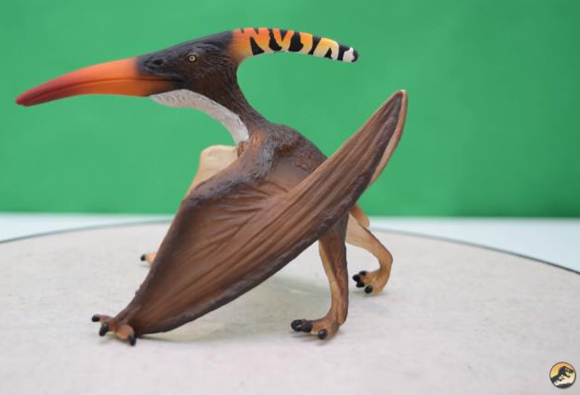Preparing a Pteranodon Information Panel
As part of their on-going work with an events management company, Everything Dinosaur team members have been asked to prepare an information panel on the famous pterosaur genus Pteranodon. The information provided will be used for a display board that accompanies a life-size Pteranodon longiceps exhibit. The Pteranodon panel is one of a series of display boards being created by Everything Dinosaur, all the other boards that staff members have been asked to create relate to dinosaurs.
A Model of the Pterosaur Pteranodon longiceps

Perhaps the most famous flying reptile of all! A model of the flying reptile known as Pteranodon (P. longiceps). Everything Dinosaur team members have been asked to create an information board to accompany a life-size museum display of this Late Cretaceous pterosaur.
Picture credit: JurassicCollectables
The image (above) shows a Pteranodon figure from the Wild Safari Prehistoric World model range.
To view this range: Wild Safari Prehistoric World Figures and Models.
The Pteranodon Information Panel
Pteranodon might be one of the best-known and extensively studied of all the Pterosauria. Around 1,200 fossil specimens are known, ironically most are fragmentary and squashed as flat as a pancake.
Name: Pteranodon (Pteranodon longiceps).
Means: Winged and Toothless.
Period: Late Cretaceous, 85 Million Years Ago (approximately).
Where are the majority of Pteranodon Fossils Found? They are found in Kansas, South Dakota and Wyoming (USA).
Pteranodon is a pterosaur, a type of extinct flying reptile and not a dinosaur! Pterosaurs were a very unusual group of reptiles that lived alongside the dinosaurs. They were the earliest back-boned animals to evolve powered flight and take to the sky. There are many species known (more than 120). The smallest had a wingspan of around 25 centimetres, whereas the largest had a wingspan of about 10 – 11 metres!
They became extinct at the end of the Cretaceous, around 66 million years ago. Pteranodon is perhaps the most famous pterosaur; the largest specimens suggest a wingspan of around 7 metres. Over a thousand specimens, from almost complete skeletons to fragmentary bones, have been found. Pteranodon fossils are associated with strata laid down in marine environments and it is thought that these flying reptiles fed on small fish.
Many Prehistoric Scenes Feature the Iconic Pterosaur Pteranodon

Dramatic scene from the Western Interior Seaway painted by Burian. Pteranodon fossils are associated with marine deposits and this explains why they are featured in prehistoric seascapes, especially those depicting the Pierre Seaway and the Western Interior Seaway.
Picture credit: Zdeněk Burian
Visit the award-winning Everything Dinosaur website: Everything Dinosaur.






Leave A Comment